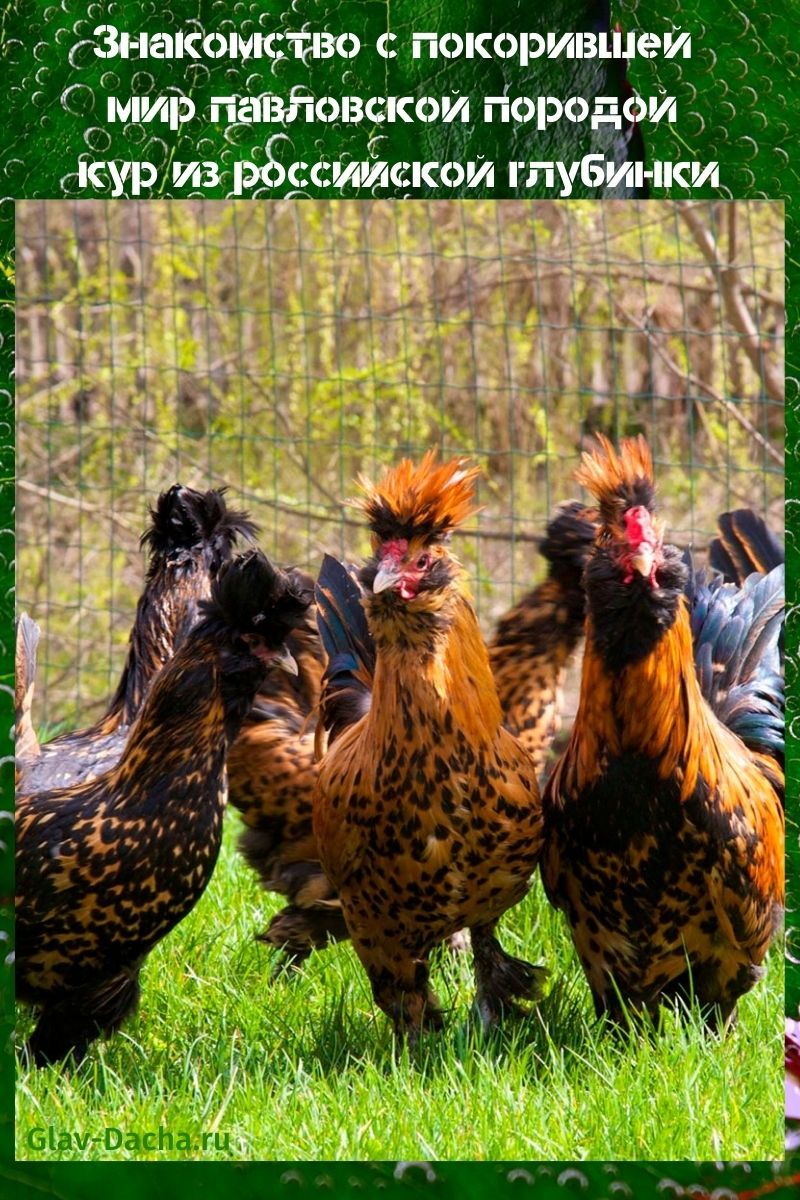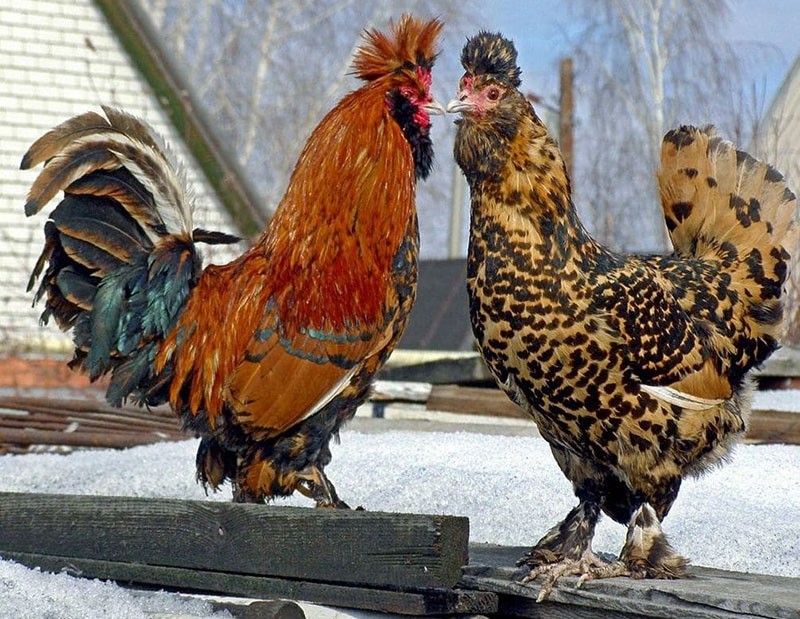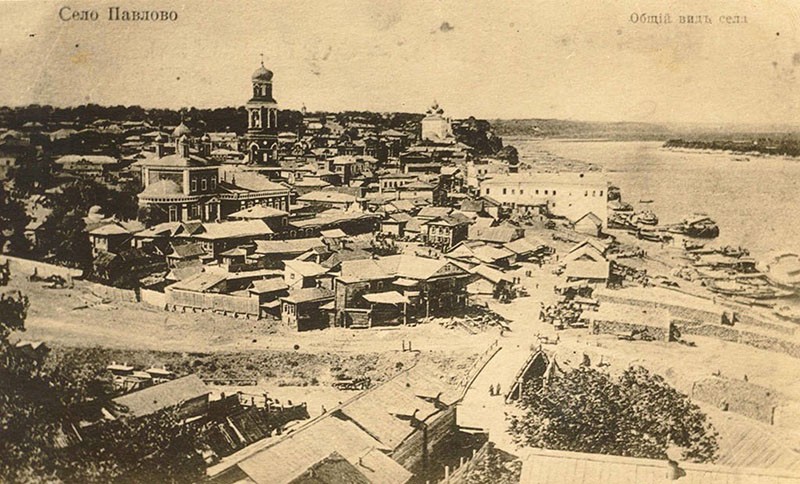Acquaintance with the Pavlovsk breed of chickens that conquered the world from the Russian hinterland
 The Pavlovsk breed of chickens is very popular among the owners of private farmsteads. This most ancient decorative breed bore the majestic name of the royal one in the century before last. Today Pavlovsky chickens are bred not only for the sake of spectacular appearance. On the scale of personal farms, their productivity indicators are very good: they get very high-quality, dietary meat from the cockerels, and young hens are quite egg-laying.
The Pavlovsk breed of chickens is very popular among the owners of private farmsteads. This most ancient decorative breed bore the majestic name of the royal one in the century before last. Today Pavlovsky chickens are bred not only for the sake of spectacular appearance. On the scale of personal farms, their productivity indicators are very good: they get very high-quality, dietary meat from the cockerels, and young hens are quite egg-laying.
The history of the appearance of the Pavlovsk breed of chickens

 Due to its excellent decorative qualities, the popularity of Pavlovsk birds began to increase. They were also brought to the territory of Europe, laying the foundation for the breeding of crested chickens there.
Due to its excellent decorative qualities, the popularity of Pavlovsk birds began to increase. They were also brought to the territory of Europe, laying the foundation for the breeding of crested chickens there.
In the 1899 century, a new Pavlovsk breed of chickens was presented at a Moscow exhibition, where it received the status of the best national breed.
During the revolution and the civil war, the Pavlovsk chicken population suffered serious damage, after which it gradually fell into oblivion. But the history of the breed continued. In the eighties of the twentieth century, a group of enthusiastic breeders decided to restore the population of these amazing birds. Taking as a basis, crested chicken breeds (Dutch, Sultan, faverole and others) they did a great job of recreating the Pavlovian breed of chickens. Today it is considered fully restored. In November 2013, a new standard was registered and today the breed is closely monitored to maintain its purity.
Pavlovsk breed of chickens - description and characteristics
 The breed standard describes important characteristics and conformation characteristics of Pavlovsk chickens. Their presence is mandatory for purebred representatives of the breed. Below you can see a photo of a rooster of the Pavlovsk breed.
The breed standard describes important characteristics and conformation characteristics of Pavlovsk chickens. Their presence is mandatory for purebred representatives of the breed. Below you can see a photo of a rooster of the Pavlovsk breed.
The Pavlovsk breed was bred specifically for breeding in the harsh climatic conditions of the northern regions of Russia. Its main distinguishing feature is its rich, dense plumage. They are larger in size than dwarfs (the weight of the rooster does not exceed 2 kg, and the hens - 1.5 kg). They are distinguished by extraordinary grace and harmony, and the presence of a tuft gives them a dapper look. Another feature is a short back, turning into a lush and beautiful tail.
These crested chickens have a small, rounded head of a proud planting, decorated with a small comb. The beak is straight, with a slightly curved tip, the eyes are round, slightly protruding, dark in color. The face of Pavlovian chickens is red, thick tanks and a beard cover a significant part of it.
The crest is of particular interest. It is compact and has a helmet-like shape or grows upward, scattering like a fountain. But in both cases, it should be slightly squeezed from the sides. The front feathers slope slightly forward, but should not touch the beak. Stalling to the sides, obstruction of vision is also considered a violation of the standard.
These birds have a gracefully curved neck that merges into a convex rib cage.They are effectively decorated with a flowing, puffy collar. The legs are also thickly feathered. A distinctive feature of Pavlovsky chickens is the presence of a "hawk" tuft on the shins, which resembles a spur. These long, fan-shaped feathers serve as bedding for birds when they settle in the snow. The lower part of the paws (metatarsus) is blue-gray, also densely feathered (moreover, the feathers are closely pressed). Normally, a bird's paw contains 4 toes.
The main decoration of Pavlovsk chickens is their luxurious plumage, which makes it possible to survive even during severe frosts. Active selection work laid the foundation for the breeding of Pavlovsk chickens of various colors.
Subspecies
 There are several varieties of the Pavlovskaya breed, differing mainly in color features.
There are several varieties of the Pavlovskaya breed, differing mainly in color features.
The most common Pavlovian golden and silver varieties:
- The breed standard gives a detailed description of the Pavlovsk golden chickens. They are extraordinarily effective. The plumage of birds has bases of a dark gold or reddish hue, and their ends are decorated with dark specks of regular shape. On certain parts of the body (crest, wings, lower back, neck, shoulders) - they are acute-angled and repeat the shape of the Latin letter V.

- Pavlovsk silvers have plumage with a white (white with silver) tint, and the general pattern of color is similar to the gold-spotted representatives.

There are also representatives of the Pavlovsk breed of chickens of white, black, yellow, fawn and variegated colors. But they are much less common and, often, have features that force them to resort to culling.
Differences between a rooster and a chicken
 Separating males from females is quite difficult until they are 2-3 months old. But experienced poultry farmers know how to determine the sex of Pavlovian chickens at an earlier age. The crests of young cockerels are more elongated, and the crests of future hens are lush and rounded. In addition, the cockerels are brighter.
Separating males from females is quite difficult until they are 2-3 months old. But experienced poultry farmers know how to determine the sex of Pavlovian chickens at an earlier age. The crests of young cockerels are more elongated, and the crests of future hens are lush and rounded. In addition, the cockerels are brighter.
 With age, there are more signs of difference. First of all, this is sexual dimorphism (males are much larger than females). On the chicken's neck, combing is noticeable (modified gill slits), and the beard and sideburns are more magnificent. But the roosters have an unusually lush and colorful tail.
With age, there are more signs of difference. First of all, this is sexual dimorphism (males are much larger than females). On the chicken's neck, combing is noticeable (modified gill slits), and the beard and sideburns are more magnificent. But the roosters have an unusually lush and colorful tail.
The nature of the Pavlovsk breed of chickens
 Pavlovsk chickens are highly active. They are very mobile, can take off high and even maneuver in the air. In addition, they are rather shy and fussy. At the moment of fright, they begin to run randomly around the chicken coop, creating a loud noise.
Pavlovsk chickens are highly active. They are very mobile, can take off high and even maneuver in the air. In addition, they are rather shy and fussy. At the moment of fright, they begin to run randomly around the chicken coop, creating a loud noise.
Roosters are very pugnacious, therefore they are not suitable for group keeping.
During skirmishes, they are aggressive, brutally attack a weaker opponent and can peck to death. But birds of other species, as a rule, are treated peacefully, calmly divide the territory with them.
At first, it will be difficult for a person without experience in keeping birds to manage such a hectic economy. Although, in general, these chickens are quite friendly to people. They quickly get used to the owner, and become attached to the place of residence.
Breed productivity
 Pavlovskaya is one of the decorative early maturing breeds. But, despite this, its production characteristics are quite high. Adults, although small (up to 2.5 kg), are rather plump, their meat is unusually tasty, with a small fat layer.
Pavlovskaya is one of the decorative early maturing breeds. But, despite this, its production characteristics are quite high. Adults, although small (up to 2.5 kg), are rather plump, their meat is unusually tasty, with a small fat layer.
 The egg production of the Pavlovsk breed of chickens is average. Each productive individual produces up to 170 medium-sized eggs (60 g) per year. In addition, the Pavlovka has a well-developed hatching instinct (they are often used to obtain offspring from other chickens). Young animals hatch well, gain weight quickly, and the survival rate of chickens reaches 92%. Pavlovsk chickens begin to lay when they reach puberty (about the fifth month of life). The productivity of layers is maintained even after reaching the age of five.
The egg production of the Pavlovsk breed of chickens is average. Each productive individual produces up to 170 medium-sized eggs (60 g) per year. In addition, the Pavlovka has a well-developed hatching instinct (they are often used to obtain offspring from other chickens). Young animals hatch well, gain weight quickly, and the survival rate of chickens reaches 92%. Pavlovsk chickens begin to lay when they reach puberty (about the fifth month of life). The productivity of layers is maintained even after reaching the age of five.
All these features make it possible to successfully combine the decorative and practical qualities of Pavlovsk chickens.Due to this, they are rightfully classified as meat and egg species of birds.
Care and maintenance of the Pavlovsk breed of chickens
 Keeping Pavlovsky chickens is not difficult, because they are unpretentious. Knowing the features of the physiology of birds, you can create ideal conditions under which their production characteristics will manifest themselves most clearly.
Keeping Pavlovsky chickens is not difficult, because they are unpretentious. Knowing the features of the physiology of birds, you can create ideal conditions under which their production characteristics will manifest themselves most clearly.
Arrangement of the poultry house and walking area
 Thanks to their dense plumage, the birds are reliably protected from winter frosts. They adapt to life even in unheated or poorly heated rooms. A prerequisite is the absence of drafts.
Thanks to their dense plumage, the birds are reliably protected from winter frosts. They adapt to life even in unheated or poorly heated rooms. A prerequisite is the absence of drafts.
Birds are kept in an aviary or a specially built room. Cage keeping is highly undesirable, since birds must have an outlet for their irrepressible energy. In addition, they will need regular walking.
On warm days, the period of stay in the fresh air should be the longest: it is useful for birds to spend all daylight hours outside.
The poultry house is built high and spacious (at the rate of one square meter for three individuals), with a large window (a source of natural light). One of the walls is provided with a closing manhole. At a height of about a meter, perches are arranged, insulated nests with egg collectors (30x30 cm) are strengthened. The floor is made of clay, insulated with a layer of sawdust or straw (it will have to be changed every 2-3 months).
 The pens are fenced off with a high partition, and a net is pulled on top (birds are able to fly over high fences). Temperature in chicken coop in winter maintained at 10 ° C, and daylight hours are extended to 15 hours using fluorescent lamps. So the egg production of chickens will not be affected.
The pens are fenced off with a high partition, and a net is pulled on top (birds are able to fly over high fences). Temperature in chicken coop in winter maintained at 10 ° C, and daylight hours are extended to 15 hours using fluorescent lamps. So the egg production of chickens will not be affected.
Feeders and drinkers
 Feeders and drinkers for chickens are made quite spacious, birds should have constant access to them. They are placed at the optimum height (chest level). Feeders are recommended to be made on legs or stands. This will keep the floor littered less as the birds scatter less feed.
Feeders and drinkers for chickens are made quite spacious, birds should have constant access to them. They are placed at the optimum height (chest level). Feeders are recommended to be made on legs or stands. This will keep the floor littered less as the birds scatter less feed.
Drinking water should always be fresh. In summer, it is changed 2-3 times a day, in winter, a single change of water is enough.
Containers for feed and water should be rinsed periodically in running water.
The hen house also provides for baths with sand, chalk and ash for bathing birds. In such baths, they get rid of skin parasites.
Power features
 A balanced diet is the key to the activity and good health of birds. For birds, a feeding regime is important, which should be strictly observed. For adult birds, this is 3-4 times a day, and for chickens - 5-6 times a day.
A balanced diet is the key to the activity and good health of birds. For birds, a feeding regime is important, which should be strictly observed. For adult birds, this is 3-4 times a day, and for chickens - 5-6 times a day.
Pavlovsk chickens do not differ in their exactingness either to the composition of the diet, or to its quantity to the diet and its quantity, but it is important to observe them to maintain good production characteristics. The basis of the diet should be high-quality feed. Additionally, they include grain ingredients, meat and bone meal, crushed chalk, natural sources of vitamins and microelements (fruits, vegetables, herbs, salt, chalk, yeast).
For laying hens, to increase egg production, a sufficient amount of protein components and potassium-containing preparations (this is low-fat milk, cottage cheese, bone meal) are included in the feed. To cleanse the stomach, chickens are given fresh grass or hay. The birds are fed three to four times a day, and most of the grain components (up to 70%) are fed in the morning. For lunch, they eat liquid ingredients - mash of herbs and vegetables. In the evening, give the rest of the grain.
During the moulting period of chickens, their food should be especially nutritious and vitamin. Birds should be kept warm at this time. Egg production during this period becomes slightly lower.
 For chickens, a chopped boiled egg is prepared, mixing it with low-fat cottage cheese or boiled cereals. After 2-3 days, add alfalfa, boiled vegetables.Older chicks are fed a variety of broth or milk-based mash, with yeast and herbs added. The diet of chickens should be varied, because it depends on how they will develop
For chickens, a chopped boiled egg is prepared, mixing it with low-fat cottage cheese or boiled cereals. After 2-3 days, add alfalfa, boiled vegetables.Older chicks are fed a variety of broth or milk-based mash, with yeast and herbs added. The diet of chickens should be varied, because it depends on how they will develop
Features of caring for chickens
 Chickens of Pavlovsk hens are born with dark or spotted down. Over time, it changes to a plumage of golden or silver tones. Chickens are very caring mothers. They warm the kids with their bodies, make sure they are not lost, teach them to look for food.
Chickens of Pavlovsk hens are born with dark or spotted down. Over time, it changes to a plumage of golden or silver tones. Chickens are very caring mothers. They warm the kids with their bodies, make sure they are not lost, teach them to look for food.  For chicks in the hen house, special lamps or heaters are arranged. The first five days after the birth of the chickens, the temperature in their pen is maintained around 30 ° C. As the babies grow, it is gradually lowered to 18-20 ° C.
For chicks in the hen house, special lamps or heaters are arranged. The first five days after the birth of the chickens, the temperature in their pen is maintained around 30 ° C. As the babies grow, it is gradually lowered to 18-20 ° C.
It is useful to observe their behavior during this time.:
- If chickens are freezing, they crowd around the heaters, trying to keep warm.
- When they are hot, they refuse to eat, lie down, often drink.
- If the temperature is comfortable, they are calm, quite active, and peck food well.
Frequent illnesses

Pavlovsk chickens by nature have a high level of immunity. Proper nutrition, competent maintenance is the key to maintaining health and high productivity. When keeping a large number of chickens, they must be vaccinated against Marek's viral disease, Newcastle pseudo-plague, Gumboro infectious bursitis.
Avitaminosis and lack of minerals in the diet can be the cause of cannibalism of chickens (birds pecking each other).
Having appeared in the Russian outback, the Pavlovsk breed of chickens began its difficult path to fame. Her livestock either decreased or increased again, returning after almost complete oblivion. Today we can say with confidence that the breed has been completely restored. Beautiful, original birds again adorn the poultry yards and private yards.